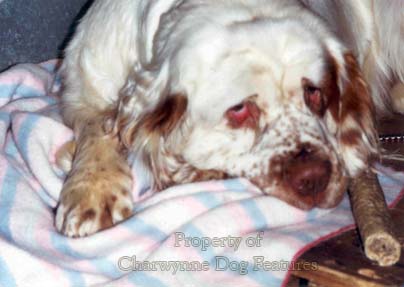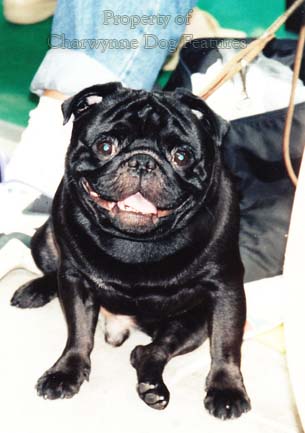457 Heading Off Exaggerations
HEADING OFF OBSESSIONS
by David Hancock
 The head of dog seems to preoccupy far too many breeders in far too many breeds. And, although I shudder when I hear a breed described as a 'head breed', an unusual fascination with the head of dog need not be damaging -- until it affects the health and well-being of the dog. A preoccupation with the head, leads not only to a neglect of the rest of the body but a harmful imposition of owner or breeder whim on a hapless animal. The heads we have inflicted upon a number of contemporary pedigree breeds demonstrate very aptly man's preference for his fad as opposed to dog's needs. It is simply not honourable to claim lamely that 'their heads have always been like that'. The honest man knows that that is not true, not historically correct. The honourable man knows that to breed subject living creatures to a harmful design is immoral, shameful and inexcusable.
The head of dog seems to preoccupy far too many breeders in far too many breeds. And, although I shudder when I hear a breed described as a 'head breed', an unusual fascination with the head of dog need not be damaging -- until it affects the health and well-being of the dog. A preoccupation with the head, leads not only to a neglect of the rest of the body but a harmful imposition of owner or breeder whim on a hapless animal. The heads we have inflicted upon a number of contemporary pedigree breeds demonstrate very aptly man's preference for his fad as opposed to dog's needs. It is simply not honourable to claim lamely that 'their heads have always been like that'. The honest man knows that that is not true, not historically correct. The honourable man knows that to breed subject living creatures to a harmful design is immoral, shameful and inexcusable.
The Kennel Club, commendably, has in recent years looked at harmful descriptions in a number of breed standards, but in my view failed to act with authority and continued to walk around the breed clubs on this issue. Overseas kennel clubs are just as guilty, but since we created more breeds of dog than any other nation, we surely have a special duty to look after them. Self-regulation which works must always be better than direction from outside, but in these days of militant animal welfare groups, it is only a matter of time before pressure from outside leads to the necessary changes being put in hand.
The KC-approved breed standard of the Bulldog needs 258 words to describe the head and an additional 200 to describe the ears, eyes, mouth and neck. Only 13 words are apparently required to cover temperament and 33 to describe gait or movement. The Bloodhound's head is, according to its breed standard, actually required to be "furnished with an amount of loose skin, which in nearly every position appears abundant, but more particularly so when head is carried low; skin then falls into loose pendulous ridges and folds, especially over forehead and sides of face." Why does the dog need this? The Mastiff's head attracts over 160 words in its standard but only 8 are deemed necessary to cover temperament.
The Clumber Spaniel's head has also attracted the exaggerators, perhaps because the wording of the breed standard is full of contradictions. The head and skull should be massive with heavy brows and a heavy muzzle yet possess "no exaggeration in head and skull". The eyes have to be slightly sunk with some haw showing. The standard of 90 years ago, according to Rawdon Lee, omits any mention of permissable haw. Of what possible value to a sporting spaniel can eyes showing haw be? An eye showing haw is a quite needless infliction on a dog, especially a sporting breed like the Clumber Spaniel, or indeed the Basset Hound too, which has to operate in close cover.
The sheer fickleness, as well as irrationality, of some pedigree dog breeders was spelt out by Edgar Farman in his "The Bulldog - A Monograph" of 1899;..."it is curious to note how great a part the fashion of the hour plays in the breeding of Bulldogs...dog breeders are at one time all for size of skull and head...At one time, the great essential is a mass of wrinkle...In-breeding has been going on to an alarming extent with the result that whilst the dog has been reduced to the required shape, his temperament and activity have been seriously impaired." But who can stop a determined group of breeders within a breed who ignore the health needs of their dogs and indulge their selfish whims?
There were squeals of protest in the show dog world a few years ago when the Council of Europe issued a resolution on the breeding of pet animals to the detriment of their health and quality of life. The parties to the European Convention for the Protection of Pet Animals stated their conviction that insufficient account is taken, in the breeding of several breeds of pet animals, of anatomical, physiological and behavioural characteristics likely to put at risk the animal's health and welfare. They placed high priority on dog and cat breeding and set out guidelines for the revision of breeding policies.
These guidelines included: setting maximum and minimum weights and heights to reduce skeletal and joint disorders like hip dysplasia; setting ratios between height and length of back to avoid disorders of the vertebral column; setting limits on the shortness of muzzle to avoid breathing and whelping difficulties; preventing the occurence of abnormal legs e.g. bowed, abnormal position of teeth, abnormalities in eyes such as extremes of size or being too deep-set or protruding too much, overlong ears or markedly folded skin and avoiding breeding from stock carrying inheritable defects.
The breeds they mentioned in connection with known disadvantages included Bulldogs (too short a muzzle, abnormal positions of teeth and excessively folded skin), Bloodhounds (ectropium, entropium, overlong ears and excessively folded skin) and St.Bernards (ectropium). Of the breeds of dog mentioned, the Basset Hound was referred to the most. If you then consult a publication like 'Medical and Genetic Aspects of Purebred Dogs' edited by Clark and Stainer and published in the United States in 1996, you can obtain even longer lists of disabilities in pedigree dogs, especially in the Bulldog, the Mastiff, the Bloodhound, the St.Bernard, the Basset Hound and the short-faced Toy breeds. The Bulldog has four whole pages devoted to it under the heading 'recognised problems'. The St.Bernard list indicates over 30 separate health defects.
Against this background, it is relevant to note that the breeds mentioned the most are those with questionable designs for their heads or the external organs located there. It would be far more justified if the outcry against docking dogs' tails were to be drowned by a huge outcry against offences concerning dogs' heads, for the latter create appreciably more pain, discomfort and prolonged distress. It is I suppose a case of tails you lose, heads you leave as they are -- to the loss of dog's health, comfort and quality of life.
Before we are shamed by a pan-European body having to produce legislation to force us to act, it would be timely if positive action were to be taken here. That doesn't mean forming a Working Party to report in four years time. That doesn't mean a round robin to breed clubs pleading for greater compassion. It means the body which regulates the purebred dog world, a body set up for the improvement of dogs and the sole authority in dogdom now producing unambiguous moral leadership.
In 'The Animals' Agenda', published in North America in November 1990, Eric Dunayer VMD wrote: "Pure breeds signal impure motives. Nature doesn't proliferate disabilities; humans do, finding them fashionable, appealing, or financially profitable. It is a cruel society that breeds and buys afflicted purebreds while healthy mixed breeds perish by the millions. Selective breeding may line some pockets and gratify some egos, but it hurts dogs". Selective breeding, however, need not hurt dogs. In Britain we have skilled dog breeders and honourable dog breeders. But they cannot act unilaterally; they need breed standards worded clearly and firmly to stamp out harmful design features. Without the British public realising it, our precious breeds are being threatened.